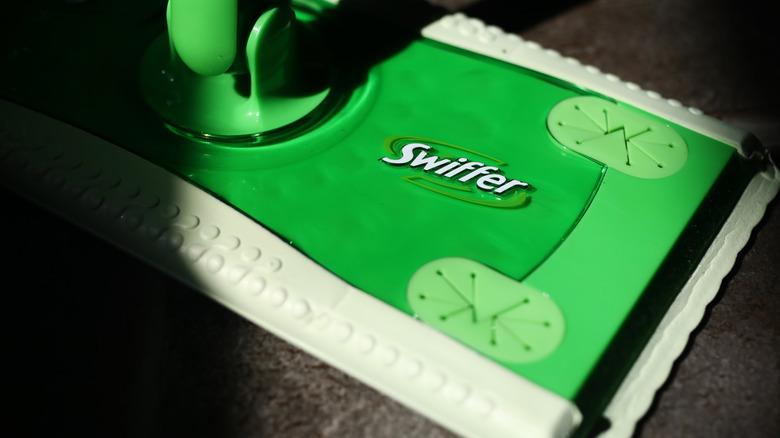Mistakes You Have To Stop Making When Using A Swiffer To Clean Your Home
We may receive a commission on purchases made from links.
Cleaning may be satisfying to some, but to others, it is the epitome of a bad time. In this day and age, there are endless cleaning products that are designed to make cleaning faster, easier, and more effective. Some have become so popular that they are now a household name. Swiffer is not only one of the most widely owned cleaning brands, but it has effectively become a verb, too, thanks to some careful marketing tactics by the company's PR team. Despite the stigma that shortcut products designed to make cleaning easier are "lazy," the fact remains that we live in a fast-paced world, and if a product helps motivate you to keep your home clean, that's reason enough to buy it. If you do find yourself buying into the quick-clean routine, the best thing you can do is learn how to make the most of it, including learning some unexpected ways to use a Swiffer and mistakes to avoid when using a Swiffer product.
While the Swiffer Sweeper was the original product offered by the company, it now has a larger range of products that help to mop, dust, and sweep your floors — plus a range of cleaning solutions designed for use on different materials. The main goal of the company has remained to eliminate the need for a broom and dustpan, and if used correctly, it's definitely possible to toss your broom for good. But the beloved grab-and-go product line is not the answer to every mess, and using products incorrectly can not only be ineffective, but in the worst case scenario it could even cause damage if you use it on the wrong surface.
Why your Swiffer is underperforming, and how to make it work
Swiffers — though useful tools — are not the answer to all of your cleaning needs. They are best used as the final clean-up crew rather than a first responder, especially if you are hoping to get the best results. One of the biggest limitations with Swiffers is that if there is too much dirt or debris it won't be able to pick it up, it will just end up pushing it around. If you vacuum first, however, Swiffers of any kind are great for picking up the tiny particles and clearing up residue.
With a few similar models out there, it's also easy to confuse the products, particularly those meant for cleaning floors. To clear up how to use their most popular floor models: The Swiffer Sweeper is designed to be used dry first in order to trap dust and dirt, and then wet to dissolve more stubborn grime. The Wet Jet is a bit more aggressive with a cleaning spray feature and a more abrasive scrub pad. These can be used on hard surfaces, though be sure to use with caution on anything that shouldn't get too wet. For the deepest clean you will want to opt for the Power Mop. This tool is larger than the Wet Jet, has a 360° swivel head and scrubbing strips that not only collect dirt but also help to loosen it from the floor. No matter which model you use, it is always best to vacuum first to prevent you from spreading around dirt rather than removing it.
Tips to save you money (and from Swiffer-related damages)
Although Swiffers may seem like an affordable option, their overall cost can actually add up pretty quick, especially if you are someone that uses them frequently. The mops and sweepers themselves cap at about $30, but that's not what gets expensive. Most of the mopping and sweeping cloths come in packs of 12-24, and cost anywhere from about $10-$15. Now that may not seem like a lot, but if you are someone that likes to do a quick run of the mop once a day, that can be an average of $25 more per month — which is $300 per year. Now, this cost isn't astronomical, but if you are looking for a way to save money and be a bit more eco-conscious, there are quite a few reusable options available, like these Yicotira Reusable Microfiber Mop Pads that are sold on Amazon in a pack of four for just $8. In a pinch, you could also use a retired fuzzy sock.
But it's not just product refills that can rack up the bills. If you aren't careful, some chemicals in Swiffer cleaning solutions or over saturation could end up damaging your floors. While this can be a quick way to shine up dull floor tiles or a vinyl surface, sealed laminate and hardwood flooring should be mopped in moderation. Unsealed floors could end up with warping, or discoloration, so it's best to stick with a dry option. If you do decide to mop your sealed wood floors, choose the wood-specific solution as it is designed to dry faster to prevent the consequences of moisture buildup.


